Last Friday, I was fortunate to be invited to speak at a QUT Energy Forum with 2 other industry stakeholders – Mike Swanston (until recently with Energex) and Richard Schoenemann (recently joined Sunverge).
It was a prior event of this type at which I’d heard Professor Gerard Ledwich speak at a couple months ago – leading to his guest article here on WattClarity.
Following on the same underlying theme (with respect to the changes the electricity supply industry is grappling with at present), we three presenters were all asked to speak on the topic of “What are, and will be, the business niches for aggregators?”
During my presentation, I indicated that I’d post some further thoughts on WattClarity later – so here’s what I managed to prepare over the weekend …
What is an aggregator, anyway?
The term “aggregator” is a term that seems to have come into vogue in recent years in the energy sector – but it was only when I started to prepare for this talk, that I stopped to think of what the term actually means, in terms of the energy sector.
Perhaps this was the reason why 3 experienced industry executives had been asked to present their own views to the audience at QUT?
Starting from first principles, I asked myself the questions – “Aggregating what? Why?”
As discussion-starters, I illustrated 11 different types of aggregators we can see currently operating in the electricity supply industry in Australia. I’m sure many readers will be able to add some more…
Some good conversations were had after the session. I’d also invite you (the reader) to contribute to this discussion – either online (below) or offline (call +61 7 3368 4064) – if you’re also interested in what could unfold.
Aggregating Electrons
As a company that strives to make complexity understandable, so our clients can make better decisions, we like diagrams. A (good) picture tells 1000 words.
Two of the diagrams that have delivered value to thousands of people over the years have been our “Power Supply Schematic” and “Power Trading Schematic” Market Map wall charts which (together) detail the physical and commercial structures of the NEM in the east and the WEM in the west.
(Massively) simplifying from the “Power Supply Schematic”, I highlighted what I believe is the original aggregator in the NEM (and other industrialised electricity industries):
Because of their role in aggregating electrons for delivery to end-users (or, conversely, aggregating dispersed energy users for centralised generation) the network companies (TNSPs and DNSPs in the NEM) could be seen as the original aggregators.
Thinking about what alternative methods there might be for delivery of power, two thoughts jumped out:
Option 1 – with growing talk of a “death spiral”, and social media chatter showing disillusioned energy users “going off grid” there is obviously a growing desire by some to “cut out the middleman” and connect generation and energy use at home directly. Whether this particular technology will cross the chasm on the adoption curve is a matter for another post sometime…
Option 2 – A second option could be thought of in the following pictorial terms – in terms of a fleet of Tesla (or equivalent) electric vehicles charging up at centralised charging points in cities whilst people work, then driving home to discharge in the evenings.
Given electric vehicles and (mobile and static) battery storage represent two of the largest looming changes to the electricity supply industry, I’ve been trying to get my head around what it might mean. We had a guest author post some back-of-the-envelope calcs in terms of what it might do to demand, and I tried to work out what it might mean in terms of balancing large-scale intermittency.
Perhaps it was somewhat naive to start with a basic bottom-up analysis such as that, but it did help to clarify to me the mismatched scale between the total peak demand requirement in the NEM and what electric vehicles might, on their own, be able to supply. Too many zeros difference for EVs to be able to handle, on their own.
However it does leave me thinking what potential network benefits might come out of providing some moderation of evening peak demand through mobile battery storage – hence potentially delivering better economic bang-for-buck than might be possible with just distributed storage at home, with a mobile battery delivering both:
(a) Some transport capability for commuters; and
(b) Some network optimisation capability, being plugged in at night, at home, when the sun’s down and residential demand begins to peak.
Perhaps delivering some benefit in oversizing the storage capacity in cars to enable greater discharge in the evening peak time (then slowly charge up again through the low hours of the night ready to drive out again the next morning)?If one of our readers knows of research that’s been done into this capability, please let me know – either in a comment below, or offline?
Aggregating Payments
When National Competition Policy reached the Australian electricity supply industry in the 1990’s and the National Electricity Market was formed at the end of that decade, a separation was created between the role of the energy deliverer and the energy retailer – thereafter creating the Electricity Retailer as another form of aggregator in the industry.
This separation of responsibilities is the reason for our separate “Power Trading Schematic”.
When (simplified and) viewed as below, the energy retailer acts by aggregating payments from (as part of the broader commercial relationship with) energy users to fund the constituent cost components upstream:
Asking the same question, again, we also see that a disruptive influence already being felt in this part of the market is with respect to the rapid growth in the number of AER-approved exempt suppliers, largely providing solar PV to residential customers behind the meter on lease-back arrangements.
I’ve posted before about the “socialised costs” apparent to me in this “exempt supplier” approach.
Delving into a bit more detail (though still a long way from the detail of the “Power Trading Schematic”) and looking just at the wholesale end of the market, we see another aggregator embodied in the role played by the AEMO, the physical Market Operator.
As noted in the slide, I can’t currently see it possible for any other organisation to emerge to compete with the AEMO as facilitator of the physical market, given the “gross pool” nature of the market design of the NEM. I also struggle to understand what potential benefits might come from a move away from this model.
On the financial side of the wholesale market, however, it’s a lot easier to see how a competing alternative to the service provided by the ASX and ASX Energy (formerly dcyphaTrade) might emerge:
Indeed, I understand that there have already been some moves afoot, in that respect.
Aggregating Customers
Still at the wholesale end of the market, we have also seen (over the 16+ years that the NEM has been operational) a number of competing firms seek to establish themselves as wholesale brokers in the market – hence aggregating customers for financial trades.
The 6 shown in the image below were the 6 firms listed in the “Power Trading Schematic” updated late in 2014.
As noted, these firms have tended to come and go over time – and there are concerns, in an environment of low volatility (and liquidity down from the heyday of 2007) whether there are too many brokers.
At the retail end of the market, I’ve been interested to see a growing number of retail energy brokers hang out their shingle, seeking to provide energy broking services to larger commercial and industrial energy users.
Some are quite large, well-established companies – whilst the largest percentage seem to be small-sized enterprises (even sole traders), many recently established by people who were formerly energy retail salespeople.
Using their position of influence (as “trusted advisor” to energy users) I started to think about what “value-add” services some might offer to capitalise on their role as an aggregator of energy procurement managers concerned about cost of energy for their enterprises.
Additions include types of services such as energy audits and the like – but also, more recently, the inclusion of on-site generation options. Cogeneration has proved not commercially compelling in many cases, but with growing concerns about emissions this has meant a more favourable business case and the reduced cost of solar also potentially makes that attractive.
Hence, in this sense, the retail broker not only aggregates C&I energy users for delivery to traditional energy retailers, the aggregation can also serve other suppliers of technology or services.
Continuing down the supply chain to the residential and small commercial customer end, we have also seen a steady increase in the number of comparison sites offering to be an energy user’s next best friend in making them feel more comfortable about their energy procurement arrangements.
In the following image I have listed some of those I know about, but it’s an area of the industry that’s rapidly evolving, so there are bound to be others you know of…
As noted on the slide, some of the marketing I have seen tends to imply that these comparison sites will deliver the lowest cost of energy (with the inference potentially being by the energy user that it’s absolutely the lowest), but I suspect one would have to read the fine print to understand that what’s actually being delivered would be a relatively low price – relative to the sub-set of available offers considered (with perhaps preference shown, in some cases, to a particular comparison sites’ favoured retailer)…
At the end of the day, given the relatively low “share of wallet” for residential user energy bill, and the “out of sight, out of mind” nature of the commodity being purchased, I wonder whether most would even really care if they understood the limitations in this approach?
For completeness, the three government-provided services (one in Victoria and one in Queensland, plus a national service elsewhere) are highlighted in the box.
Aggregating Data
The electricity supply industry has always been one reliant on a large amount of frequently changing data to manage the balance between supply and demand.
Traditionally, the “big data” has been mostly concentrated at the wholesale end of the industry, with old-style accumulation meters satisficing further down at the retail end.
Even in that paradigm, another category of aggregator was formed with the establishment of the Meter Data Agent, as a responsibility distinct to retailing and distribution. In practice, most MDAs operate under the same form of branding as “the usual suspect” retailers/DNSPs, but some subsidiaries are (at least) branded separately from the network arms.
Moving into a “Smart-Grid” world, and with the “Internet of Things” just around the corner, the escalating load of data might easily become deafening noise, if not for the ability that some companies are exploring to mine the masses of customer consumption data to turn it into something useful (i.e. aggregated insights).
Feeding these insights into techniques to help achieve desirable outcomes (such as moderating peak demand) are the types of objectives that might be a focus.
I am aware that Opower has appointed local Australian staff but am not sure about the other two US companies listed. There are probably other local companies that operate in the same space (please let us know who you are!)
Reversing the flow of the data, we come to an illustration of what is part of our business model – in that we aggregate data from a number of different sources, then present it in clear displays to help people make time-sensitive decisions relating to trading, operations, business development and energy policy etc…
As time permits, we try to share some insights with you on WattClarity as another service in making complexity more understandable.
Aggregating Eyeballs.
Thinking back to the way the electricity industry was a decade or more ago, the general public really didn’t care to know too much at all – so long as the lights stayed on, and the power bill was not a surprise.
Some days we might say that that part has not changed too much – but is that really the case?
Raised awareness of the environment, emergent technologies being more up the community “excitement scale”, and the growing social media ecosystem are combining to give everyone the opportunity to feel like an armchair expert – weighing into debate and discussion about an energy sector that would have, a decade or more ago, triggered mass narcolepsy had it been spoken about at the neighbourhood barbeque.
Even within the NEM, where there used to be a limited number of organisations (like the QEC, ECNSW, SECV, ETSA and HydroTas), there’s now a great number more – each with their own policy, strategy and operations people.
What this has seemed to mean is an increase in the number of media organisations springing up, providing avenues for the aggregation of eyeballs (or bodies, in the case of conference companies) – focused specifically on the energy sector.
The services pulling the biggest audiences seem to be attractive targets for energy-sector-specific advertising, and related models.
Aggregating “NegaWatts”.
The last example I gave was one that has not formally started yet in the NEM – but which, following the submission of this rule change request by the COAG Energy Council to the AEMC in March 2015, should be implemented when the process has worked through:
As noted in the image above, I previously posted some thoughts about the unfortunate naming of the both the “Demand Response Mechanism”, and the unfortunate naming of the new type of market participant that is to be created – the “Demand Response Aggregator”. For those interested, these other thoughts might also be useful.
We’ll continue to watch with interest as the new rule is implemented and swings into action.
At the conclusion of the brain-storming session in preparation for this brief talk, I came to the clear realisation that there is plenty of opportunity present in many different niches for new and old forms of “aggregators”.
The above are some of those that I have had time to post about today…


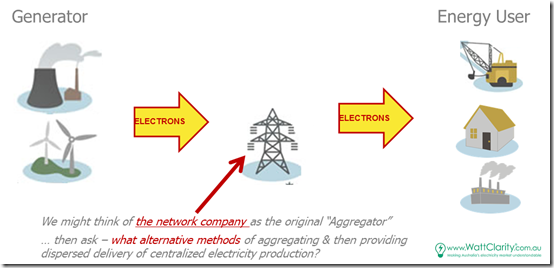
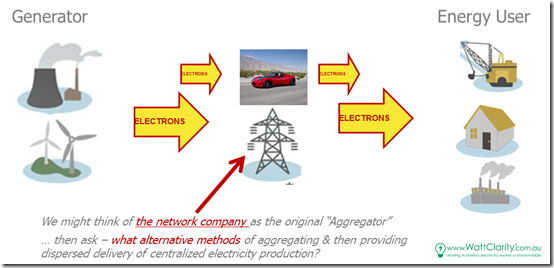
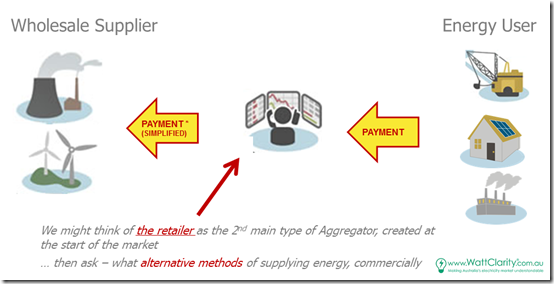
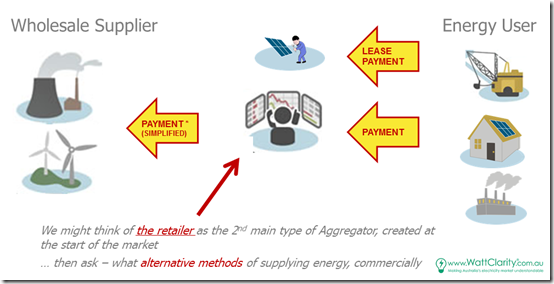
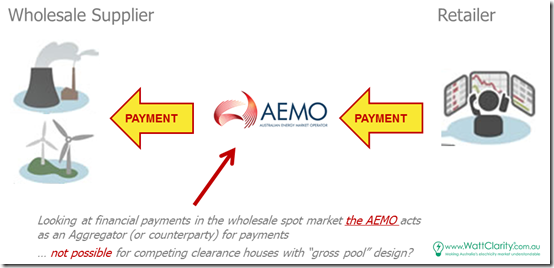
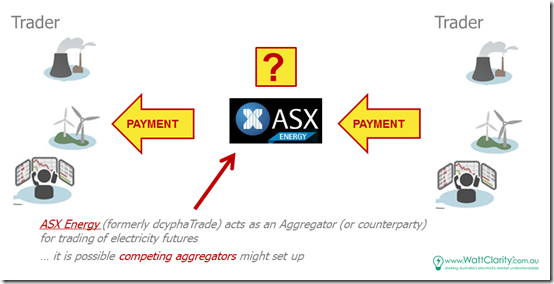
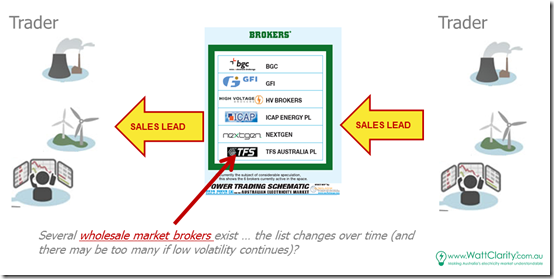
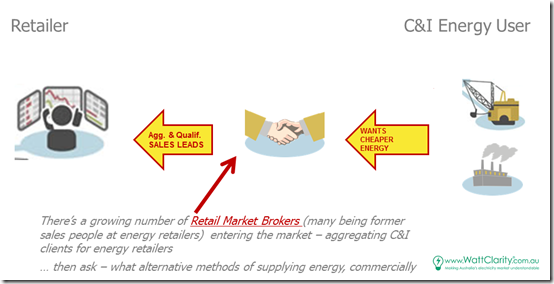
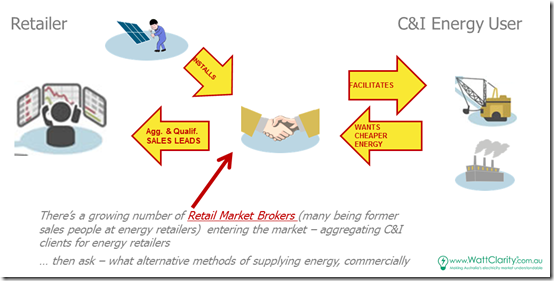
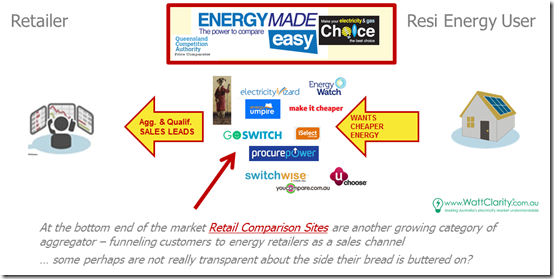
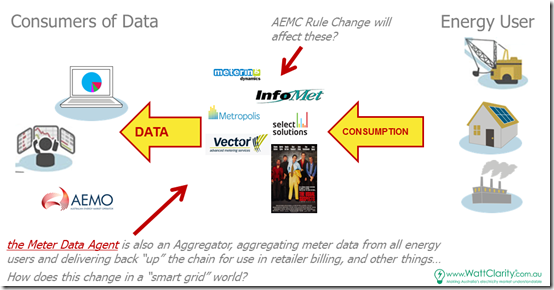
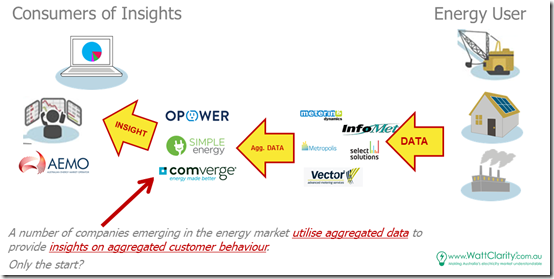
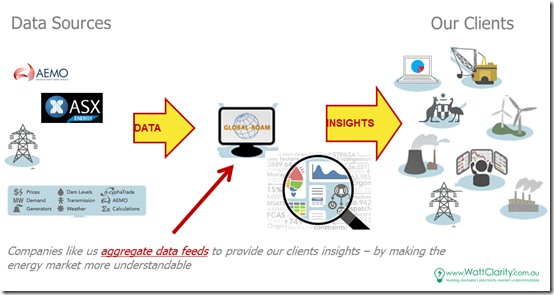
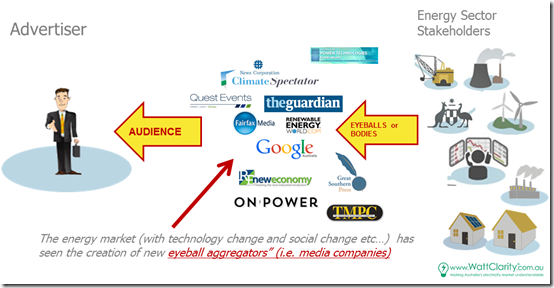
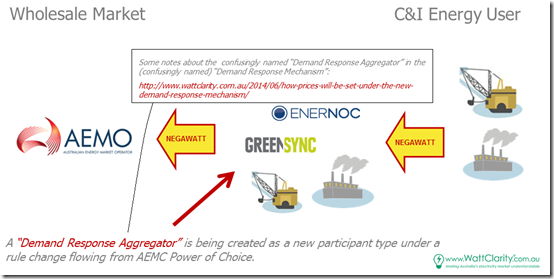
One of our readers has emailed in with these additions:
1) Another one that you may want to include is the role of aggregators for green and white certificate creation – eg STC, LGC, VEET and ESC schemes.
2) And it would seem with the recent ERF auctions that aggregators were the prodominat suppliers of projects into the ERF for abatement…
UChoose is the only Unbiased Comparison Service(aggregator) – the only one in Australia which receives the same commission irrespective of which offer the Customer chooses. Plus we do not have any preferred partners or sponsored offers. True choice and unbiased.
With respect to Comparator Websites, the ACCC has released this informative guide: